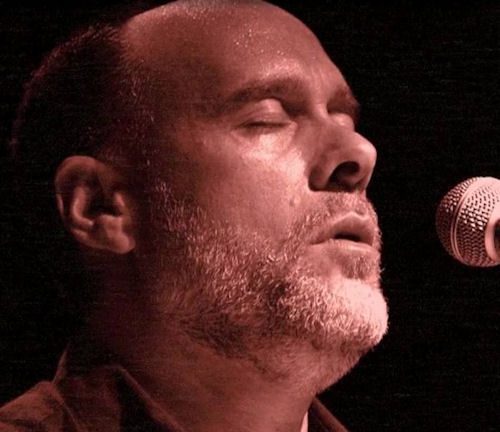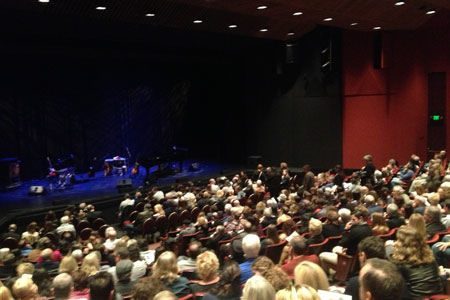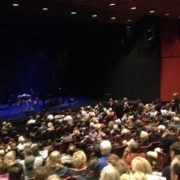WALKING IN MEMPHIS: MARC COHN IN CONCERT
MARC COHN IN CONCERT
Pepperdine Smothers Theatre – JANUARY 16, 2016
Reflections on the 25th Anniversary
Of Walking in Memphis
 Singer-Songwriter Marc Cohn broke through to a national audience 25 years ago with his 1991 hit Walking in Memphis. But before he could walk in Memphis this Cleveland songwriter had to fly there, and thereby hangs a tale. James Taylor no less gave him the idea—to break out of a spell of writer’s block. Taylor told him to “try a geographic,” change his locale, get out of familiar places and habits and shake his mind up so it might be receptive to new experiences and ideas. Marc Cohn was telling this story last night by way of introducing his hit song and how it came to be written.
Singer-Songwriter Marc Cohn broke through to a national audience 25 years ago with his 1991 hit Walking in Memphis. But before he could walk in Memphis this Cleveland songwriter had to fly there, and thereby hangs a tale. James Taylor no less gave him the idea—to break out of a spell of writer’s block. Taylor told him to “try a geographic,” change his locale, get out of familiar places and habits and shake his mind up so it might be receptive to new experiences and ideas. Marc Cohn was telling this story last night by way of introducing his hit song and how it came to be written.
He put on Carl Perkins’ “blue suede shoes,” of course, and made sure to mention Elvis—whose mansion Graceland (also mentioned) remains a national magnet for the city where he got his start. The song also references “Reverend Al Green” (yes, the same Al Green who is the soul singer most days of the week).
Walking in Memphis
I was walking with my feet ten feet off of Beale
Walking in Memphis
But do I really feel the way I feel?
James Baldwin brought that fabled street to my attention back in 1975, with his powerful novel If Beale Street Could Talk—even though his love story was set in Harlem. Baldwin got the line from the father of the blues himself—also referenced in Cohn’s narrative song as a kind of guardian angel—W.C. Handy, whose Beale Street Blues was written one hundred years ago in 1916. Handy lived at 352 Beale, now a historic site. If it was good enough for James Baldwin and W.C. Handy I figured, it was good enough for Marc Cohn. So all the reference points were in place—you knew you were in Memphis—home of the blues.
Except for one thing—this was not 1955—when Elvis walked into Sun Records studio and recorded for Sam Phillips. This song was born thirty years later in 1985—six years before it was released. Let me see? Did anything happen in Memphis between 1955 and 1985? Anything we may still remember? Oh yes, didn’t something happen at the Lorraine Motel? On the balcony? On the night of April 3, 1968? Wasn’t somebody assassinated?
https://www.youtube.com/watch?v=KK5YGWS5H84
Oh yes—now I remember—not the King of Rock and Roll—King himself—Martin Luther King, Jr. That would be Dr. Martin Luther King, and not to put too fine a point on it—the Reverend Dr. Martin Luther King. So if you’re going to put a reverend in the song, why Al Green; why not Rev. Martin Luther King?
Were I to walk in Memphis today, or in 1985, seventeen years after the bullet that changed America forever, that’s the first place I would go to—the Lorraine Motel—that I would want to see for myself—not Graceland. I wouldn’t be so graceless as to bring this up; I know how to behave in public. Except for one thing; this concert was being given during Martin Luther King’s holiday weekend, on January 16. Check the newspaper ads; even Macy’s knows it’s “MLK Weekend,” many TV spots have mentioned it; go into any bank and you will see it mentioned. I thought perhaps the man who wrote Walking In Memphis might have walked a little further tonight, and brought it up in his lengthy introduction—but not a word. If Beale Street could talk today I wonder what it might say.
As I write these reflections it’s Sunday morning at 11:00am and I am listening to Lisa Finnie’s wonderful show The Dylan Hour on KCSN 88.5 FM, which she opens with Dylan singing Kris Kristofferson’s song They Killed Him—about Gandhi, King and Jesus; here is the second verse:
Another man from Atlanta, Georgia
By name of Martin Luther King
He shook the land like the rolling thunder
And made the bells of freedom ring today
With a dream of beauty that they could not burn away
Just another holy man who dared to make a stand
My God, they killed him.
Lisa Finnie gets it; she devoted the following 16 minutes of her broadcast to Martin Luther King’s I Have a Dream Speech from the March on Washington, before continuing with Bob Dylan’s performance from the March—on August 28, 1963—of his just-penned song for Medgar Evers, assassinated two and a half months before, Only a Pawn In Their Game.
Other than that, Mrs. Lincoln, how did you like the concert? It was a wonderful concert, and taught me something about the art of live performance, which I am happy to pass on to you. I had never seen Mr. Cohn before, and having just seen Van Morrison the night before I was in a relaxed mode, fully aware of the difference in venue from the 6,000+ Shrine Auditorium to the comfortable small college Smothers Theatre. It was a joy to be in an auditorium where you could see the artist clearly, and hear every word. But there are some things they could learn from a place like the Shrine; so for the sake of those who may be taking notes, let me tell you how the big boys do it: the Shrine introduction of the show was a masterpiece of economy, a “brevity is the soul of wit” intro; after the band came out unannounced and set up, and a long pause, the announcer has four simple words: “Ladies and gentlemen, Van Morrison!” after which Van the Man walked out to microphone, picked up his sax, and without further ado, started playing.
Pretty basic, but I didn’t fully appreciate its elegance until the Pepperdine College “introduction” of Mark Cohn. Let me try to recapitulate it from notes and memory: “Ladies and gentlemen, welcome to the Smothers Theatre; there is no photography or recording allowed; please observe where the exits are in case of an emergency; now turn down your cell phones to the vibrate only or off position; thank you and enjoy the performance.” After which…after which….nothing happened—for an agonizing two minutes. No mention of Mark Cohn, no mention of the artist we had all come to hear, and so the sold-out audience just sat and waited until finally the lights dimmed, and Mr. Cohn walked out unannounced onto the stage and assumed his place behind the grand piano and gave a nice wave to the audience. The difference between how AEG Live introduced Van Morrison and how Lisa Wengler Arts Center never really introduced Marc Cohn was palpable and revealing. Somebody on their staff should leave the ivory tower once in a while and go down to the Shrine, or the Greek, or the Bowl, and find out how it’s done. Because they haven’t a clue. But Cohn quickly pulled the show together with his opening Walk Through This World. (He uses the image of walking a lot; it worked in Memphis.)
 Marc Cohn won the Best New Artist Grammy Award in 1992, on the strength of his debut eponymous album with the hit song now celebrating its 25th anniversary. He has a loyal fan base and they packed the Smothers Theatre to hear him. The couple sitting in front of me spoke highly of him while we were waiting for the show to begin. I can tell when an artist has really a deep connection to his fans, and Cohn clearly does. I can feel it in the auditorium. He plays piano for most of the concert, but very expressive guitar for a few songs too, including the final song, a beautifully crafted One Safe Place, about the hope everyone has for finding someone who can offer safe haven from the storms of life.
Marc Cohn won the Best New Artist Grammy Award in 1992, on the strength of his debut eponymous album with the hit song now celebrating its 25th anniversary. He has a loyal fan base and they packed the Smothers Theatre to hear him. The couple sitting in front of me spoke highly of him while we were waiting for the show to begin. I can tell when an artist has really a deep connection to his fans, and Cohn clearly does. I can feel it in the auditorium. He plays piano for most of the concert, but very expressive guitar for a few songs too, including the final song, a beautifully crafted One Safe Place, about the hope everyone has for finding someone who can offer safe haven from the storms of life.
Cohn is not shy about telling us of the storms that have beset him, either: before the show is over we learn of his two divorces (the second a very public messy divorce from ABC anchorwoman Elizabeth Vargas), four children (whom he says are all he wants, lest some unsuspecting young woman in the audience think of becoming Mrs. Cohn # 3.) That may be TMI—too much information, at least for this setting, but the audience seems to take it all in good humor. Then I find out that this concert was rescheduled from last year—for one that was cancelled due to spinal surgery. “Wow!” I think, “That’s not appendicitis; he’s had his share of turmoil.”
But that’s not the half of it, for I find out from reading the concert program that in August of 2005, upon entering his van with his band after a concert in Colorado, Marc Cohn was shot in the head by a would-be carjacker. The bullet entered his left temple but miraculously stopped just millimeters short of entering his skull. The ER doctors described him as “the luckiest unlucky man they had seen in a long, long time.” After removing the bullet and eight hours observation they released him, without further medical intervention called for. Unfortunately, that was not the end of the story. He suffered from post-traumatic stress syndrome and it was ten long years before he could get back in the studio to continue his recording career.
There is no soap opera like a Jewish soap opera, and Marc Cohn is a very visible heart-on-his-sleeve self-revealing Jewish artist. The one thing he is not is self-aggrandizing. If he’s laughing at anyone it’s himself. His one “holiday” song performed last night he refreshingly described as by “a brooding Jew.” The key line in his major hit Walking in Memphis turns on the fact that it was a homage to southern gospel music written by a Jewish songwriter. No one else could have penned the final brilliant verse and couplet:
Now Muriel plays piano
Every Friday at the Hollywood
And they brought me down to see her
And they asked me if I would —
Do a little number
And I sang with all my might
And she said —
“Tell me are you a Christian child?”
And I said “Ma’am I am tonight”
“Muriel” was Muriel Davis, a real and charismatic gospel singer who inspired his song and whom he compared to the great Alberta Hunter in the song’s introduction last night. He played the song for Muriel after he wrote it and she commented that “the last verse is the best of all—and that’s your best song.” She had it right, he observed.
But it’s not his only good song; Marc Cohn touched on a number of themes during his generous two-hour concert; a moving love song called “True Companion,” of which he charmingly mentioned to the audience, “I’m glad it worked for you, even if it didn’t work for me;” a lovely song for his oldest daughter called “Things We Handed Down,” on the most important things parents may bequeath their children, and the aforementioned “One Safe Place,” a contemporary Dylanesque song he played on his vintage Gibson acoustic, with a capo on the 5th fret, and a delicate finger-style accompaniment—just beautiful.
Like George Gershwin, another Jewish songwriter whose music was transformed and elevated by his personal contact with black culture when he was researching spirituals in southern black churches doing research for the opera Porgy and Bess, Marc Cohn explored this new world to expand his songwriting horizons and wound up discovering gold. The riveting standing ovation he earned at the end of his concert is testament to that. He writes about family, other long-admired musicians (like a very moving tribute to Van Morrison in Dig Down Deep), and iconic American symbols like his joyful celebration of the Silver Thunderbird. He tours with an outstanding three-piece band on pedal steel, lead guitar and old-fashioned percussion (not a drum kit). It’s a folk-oriented approach with a pop sensibility, and he strikes an intimate conversational tone that engages the audience with both his personal story and his songs. Happy 25th Anniversary!
Thank you to Pepperdine’s Chelsea Sutton for the invitation and press pass to hear him. Marc Cohn will be back in Southern California in August (in Beverly Hills) so stay tuned. If you missed him this time around you will have a second chance this year. Check the FolkWorks Calendar for details. Consult Marc Cohn’s website.
Saturday March 5 from 5:00pm to 7:00pm, Ross Altman will be performing a program of Woody Guthrie Dust Bowl Ballads and popular songs from the 1940s at the opening of a book exhibit about photographer Dorothea Lange and her classic Dust Bowl portrait Migrant Mother, Nipomo, California 1937, at the Old Town Newhall Library, 24500 Main St. Santa Clarita, CA 91321 661-259-0750.
Ross Altman performs in the Voice In the Well Production Chimes of Freedom Flashing with spoken word artists Sunday March 20, 2016 5:00pm to 7:00pm; $10 at Beyond Baroque Literary Arts Center, 681 Venice Blvd, Venice, CA 90291 310-822-3006.
Los Angeles folk singer Ross Altman has a PhD in Modern Literature; Ross may be reached at greygoosemusic@aol.com













